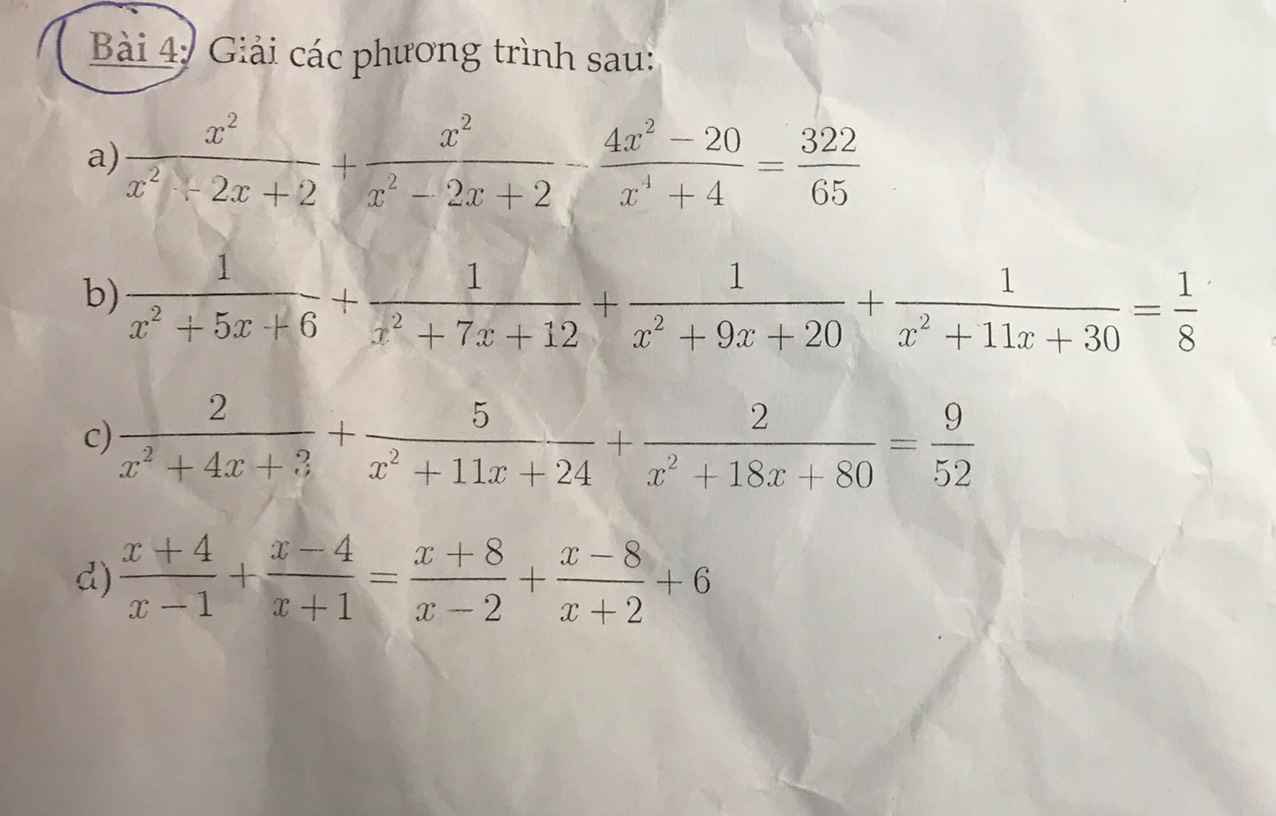Một số tự nhiên n chia 7 dư 10; chia 9 dư 11. Tìm số dư khi chia n cho 110
Hãy nhập câu hỏi của bạn vào đây, nếu là tài khoản VIP, bạn sẽ được ưu tiên trả lời.


\(A=\left(\dfrac{x+1}{x^3-1}-\dfrac{1}{x-1}\right)\left(\dfrac{x+2}{x-1}-\dfrac{1}{x}\right)\left(x\ne1;0\right)\\ =\left[\dfrac{x+1}{\left(x-1\right)\left(x^2+x+1\right)}-\dfrac{x^2+x+1}{\left(x-1\right)\left(x^2+x+1\right)}\right]\left[\dfrac{x\left(x+2\right)}{x\left(x-1\right)}-\dfrac{x-1}{x\left(x-1\right)}\right]\\ =\dfrac{x+1-x^2-x-1}{\left(x-1\right)\left(x^2+x+1\right)}\cdot\dfrac{x^2+2x-x+1}{x\left(x-1\right)}\\ =\dfrac{-x^2}{\left(x-1\right)\left(x^2+x+1\right)}\cdot\dfrac{x^2+x+1}{x\left(x-1\right)}\\ =\dfrac{-x}{\left(x-1\right)^2}\\ =\dfrac{-x}{x^2-2x+1}\)
ĐKXĐ: \(x\notin\left\{1;0\right\}\)
\(A=\left(\dfrac{x+1}{x^3-1}-\dfrac{1}{x-1}\right)\left(\dfrac{x+2}{x-1}-\dfrac{1}{x}\right)\)
\(=\left(\dfrac{x+1}{\left(x-1\right)\left(x^2+x+1\right)}-\dfrac{1}{x-1}\right)\cdot\left(\dfrac{x\left(x+2\right)-x+1}{x\left(x-1\right)}\right)\)
\(=\dfrac{x+1-x^2-x-1}{\left(x-1\right)\left(x^2+x+1\right)}\cdot\dfrac{x^2+x+1}{x\left(x-1\right)}\)
\(=\dfrac{-x^2}{\left(x-1\right)\cdot x\left(x-1\right)}=\dfrac{-x}{\left(x-1\right)^2}\)

$2^{4-x}=128$
$\Rightarrow 2^{4-x}=2^7$
$\Rightarrow 4-x=7$
$\Rightarrow x=4-7$
$\Rightarrow x=-3$
\(2^{4-x}=128\)
\(2^{4-x}=2^7\)
\(4-x=7\)
\(x=4-7\)
\(x=-3\)

a: Xét (O) có
CM,CA là các tiếp tuyến
Do đó: CM=CA và OC là phân giác của góc MOA
Xét (O) có
DM,DB là các tiếp tuyến
Do đó: DM=DB và OD là phân giác của góc MOB
AC+BD
=CM+MD
=CD
b: \(\widehat{COD}=\widehat{COM}+\widehat{DOM}=\dfrac{1}{2}\cdot\widehat{MOA}+\dfrac{1}{2}\cdot\widehat{MOB}\)
\(=\dfrac{1}{2}\left(\widehat{MOA}+\widehat{MOB}\right)=\dfrac{1}{2}\cdot\widehat{AOB}=90^0\)
=>ΔCOD vuông tại O
c: Xét ΔCOD vuông tại O có OM là đường cao
nên \(OM^2=MC\cdot MD\)

Bài 4:
d:
ĐKXĐ: \(x\notin\left\{1;-1;2;-2\right\}\)
\(\dfrac{x+4}{x-1}+\dfrac{x-4}{x+1}=\dfrac{x+8}{x-2}+\dfrac{x-8}{x+2}+6\)
=>\(\dfrac{\left(x+4\right)\left(x+1\right)+\left(x-4\right)\left(x-1\right)}{\left(x-1\right)\left(x+1\right)}=\dfrac{\left(x+8\right)\left(x+2\right)+\left(x-8\right)\left(x-2\right)+6\left(x-2\right)\left(x+2\right)}{\left(x-2\right)\left(x+2\right)}\)
=>\(\dfrac{2x^2+8}{\left(x-1\right)\left(x+1\right)}=\dfrac{2x^2+32+6x^2-24}{\left(x-2\right)\left(x+2\right)}\)
=>\(\dfrac{2x^2+8}{x^2-1}=\dfrac{8x^2+8}{x^2-4}\)
=>\(\left(2x^2+8\right)\left(x^2-4\right)=\left(8x^2+8\right)\left(x^2-1\right)\)
=>\(2x^4-32=8x^4-8\)
=>\(-6x^4=24\)
=>\(x^4=-4\left(loại\right)\)
Vậy: Phương trình vô nghiệm
c:
ĐKXĐ: \(x\notin\left\{-1;-3;-8;-10\right\}\)
\(\dfrac{2}{x^2+4x+3}+\dfrac{5}{x^2+11x+24}+\dfrac{2}{x^2+18x+80}=\dfrac{9}{52}\)
=>\(\dfrac{2}{\left(x+1\right)\left(x+3\right)}+\dfrac{5}{\left(x+3\right)\left(x+8\right)}+\dfrac{2}{\left(x+8\right)\left(x+10\right)}=\dfrac{9}{52}\)
=>\(\dfrac{1}{x+1}-\dfrac{1}{x+3}+\dfrac{1}{x+3}-\dfrac{1}{x+8}+\dfrac{1}{x+8}-\dfrac{1}{x+10}=\dfrac{9}{52}\)
=>\(\dfrac{1}{x+1}-\dfrac{1}{x+10}=\dfrac{9}{52}\)
=>\(\dfrac{9}{\left(x+1\right)\left(x+10\right)}=\dfrac{9}{52}\)
=>(x+1)(x+10)=52
=>\(x^2+11x-42=0\)
=>(x+14)(x-3)=0
=>\(\left[{}\begin{matrix}x=-14\left(nhận\right)\\x=3\left(nhận\right)\end{matrix}\right.\)
b:
ĐXKĐ: \(x\notin\left\{-2;-3;-4;-5;-6\right\}\)\(\dfrac{1}{x^2+5x+6}+\dfrac{1}{x^2+7x+12}+\dfrac{1}{x^2+9x+20}+\dfrac{1}{x^2+11x+30}=\dfrac{1}{8}\)
=>\(\dfrac{1}{\left(x+2\right)\left(x+3\right)}+\dfrac{1}{\left(x+3\right)\left(x+4\right)}+\dfrac{1}{\left(x+4\right)\left(x+5\right)}+\dfrac{1}{\left(x+5\right)\left(x+6\right)}=\dfrac{1}{8}\)
=>\(\dfrac{1}{x+2}-\dfrac{1}{x+3}+\dfrac{1}{x+3}-\dfrac{1}{x+4}+\dfrac{1}{x+4}-\dfrac{1}{x+5}+\dfrac{1}{x+5}-\dfrac{1}{x+6}=\dfrac{1}{8}\)
=>\(\dfrac{1}{x+2}-\dfrac{1}{x+6}=\dfrac{1}{8}\)
=>\(\dfrac{x+6-x-2}{\left(x+2\right)\left(x+6\right)}=\dfrac{1}{8}\)
=>(x+2)(x+6)=32
=>\(x^2+8x-20=0\)
=>(x+10)(x-2)=0
=>\(\left[{}\begin{matrix}x=-10\left(nhận\right)\\x=2\left(nhận\right)\end{matrix}\right.\)
a: \(\dfrac{x^2}{x^2+2x+2}+\dfrac{x^2}{x^2-2x+2}-\dfrac{4x^2-20}{x^4+4}=\dfrac{322}{65}\)
=>\(\dfrac{x^2\left(x^2-2x+2\right)+x^2\left(x^2+2x+2\right)-4x^2+20}{\left(x^2+2x+2\right)\left(x^2-2x+2\right)}=\dfrac{322}{65}\)
=>\(\dfrac{x^4-2x^3+2x^2+x^4+2x^3+2x^2-4x^2+20}{x^4+4}=\dfrac{322}{65}\)
=>\(\dfrac{2x^4+20}{x^4+4}=\dfrac{322}{65}\)
=>\(322\left(x^4+4\right)=65\left(2x^4+20\right)\)
=>\(322x^4+1288-130x^4-1300=0\)
=>\(192x^4=12\)
=>\(x^4=\dfrac{1}{16}\)
=>\(\left[{}\begin{matrix}x=\dfrac{1}{2}\left(nhận\right)\\x=-\dfrac{1}{2}\left(nhận\right)\end{matrix}\right.\)

Bạn bấm vào biểu tượng ![]() để nhập các công thức toán học cho rõ ràng nhé!
để nhập các công thức toán học cho rõ ràng nhé!
Vd:\(3^{10}\)

Ta thấy \(100⋮4,100-x⋮4\Rightarrow x⋮4\)
\(18⋮9,90⋮9,18+90+x⋮9\Rightarrow x⋮9\)
Điều này có nghĩa là \(x\in BC\left(9,4\right)=\left\{0,36,72,108,...\right\}\)
Tuy nhiên, vì \(x\le22\) nên \(x=0\) là số tự nhiên x duy nhất thỏa mãn đề bài.
Lời giải:
$100-x\vdots 4$. Mà $100\vdots 4\Rightarrow x\vdots 4$
$18+90+x\vdots 9$, mà $18\vdots 9, 90\vdots 9$ nên $x\vdots 9$
Vậy $x\vdots 4, x\vdots 9$
$\Rightarrow x\vdots 36$
Mà $x$ là số tự nhiên không vượt quá $22$ nên $x=0$

$18\times\left(\frac{19191919}{21212121}+\frac{88888}{99999}\right)$
$=18\times\left(\frac{19}{21}+\frac{8}{9}\right)$
$=18\times\frac{113}{63}=\frac{226}{7}$
Lời giải:
$18\times (\frac{19191919}{21212121}+\frac{88888}{99999})$
$=18\times (\frac{19}{21}+\frac{8}{9})=18\times \frac{113}{63}=\frac{226}{7}$

Lời giải:
$111\times 113\times 117\times 119=\overline{....3}\times 117\times 119$
$=\overline{....1}\times 119=\overline{...9}$
Vậy tích trên có tận cùng là 9.
Có : 1 x 3 x 7 x 9 = 3 x 7 x 9 = 21 x 9 = 189
⇒ Chữ số tận cùng của kết quả dãy tính 111 x 113 x 117 x 119 là 9.


Sai đề! Làm sao số dư lớn hơn số chia được?